by Winding Pathways | Jul 28, 2022 | (Sub)Urban Homesteading, Birds, Nature
Views From the Recliner
Guest Blogger, Susan Fellows
My first-floor, corner apartment sits on the edge of a large green space and parking lot surrounded by a stand of pines, maples, and oaks. On one side is a complex of boutique stores, restaurants, and apartments/condos. Nearby and opposite the greenspace is a residents’ home for memory care. Last year I had placed outside my living room window a double shepherd’s crook feeder visible from my recliner. I am older and have some medical issues that restrict movement. So, a good view of the outside and the birds is important to me. They are entertaining! That first year I had what seemed like a million new sparrows that went through the wild bird seed like crazy. This year, I haven’t seen as many newly fledged sparrows.
Attracting a Variety of Birds
This year I put out several feeders on the double shepherd’s crook – one for black oil sunflowers and another for wild bird seed. Also on that post, I have a “cage” of suet and a sock of blick niger thistle seed. A couple of months ago I added a single shepherd’s crook with a mealy worm feeder. This spring and early summer I have seen pairs of the house and purple finches, house and chipping sparrows, several pairs of goldfinches, and at least one pair of bluebirds. They come to the sunflower and thistle seed, which the goldfinches seem to prefer. About a week ago, a mockingbird started coming and feeds entirely on the suet. Recently I put out wild bird food which hangs from the other hook on the double shepherd’s crook. I had put out mealy worms that I prefer the bluebirds have, but the house and chipping sparrows decided they own it. Flying over and calling from the grassy area are killdeer. With their shrill call, they are easy to spot as they hobble away with their fake broken wing act to lure predators from their ground nest. They nest in low vegetation, like the nearby grassy lawn.
-

-
A water source helps attract birds.
-
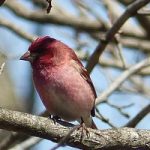
-
Some birds homestead at Winding Pathways.
-
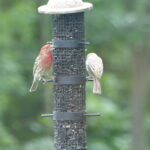
-
The house finches eat serenely.
Fledging Bluebird
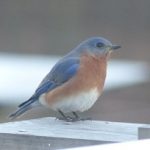
Male Bluebird
The memory home nearby has a bluebird nesting box on the quiet side of the building. I believe that is where the bluebirds come from.to feed. Several days ago I heard quite a racket from the feeding station. Looking outside, I spotted a fairly large bird with a highly streaked white breast, perched on the top of the single shepherd’s crook. An adult bluebird was also on the feeder. The bird making the racket had its beak open waiting for the adult to feed it. It didn’t. It was time for the baby to learn to eat on its own. At that point, I could see bright blue in its tail feathers. I was so excited! It was a baby bluebird!
Another day, I was looking out my window when suddenly a little, male chipping sparrow with his chestnut top on his head arrived bringing with him a smaller bird that landed close to him, beak open. Dad bird fed baby bird several pieces of seed and then showed baby bird how to do it, but as I watched baby still hadn’t got the hang of it.
Invasion by New Comers to the Feeder
A newcomer at the mealy worm feeder appeared recently – starlings. I was invaded by baby starlings. At least 15 had taken over the feeders. To lure them away from the hanging feeders, I put out a seed block on the ground at the base of the other feeders. Although I can’t see it, I expect the starlings may be happier at it than just eating crumbs from the open mealy worm feeder. I hope they will leave soon. They eat everything.
I have enjoyed sharing all these spring bird-related events with Winding Pathways. I expect to be inundated with newly fledged sparrows any time soon. Enjoy your birding adventures as I have enjoyed what I can see from my recliner.
by Marion Patterson | Jul 21, 2022 | (Sub)Urban Homesteading, Nature
Nearly everyone remembers a brief, often scary time. Usually, it comes within months of high school graduation. It’s time to leave the familiarity of home and venture out on new endeavors. Change is often exciting but it requires venturing out into the unknown – often alone.
Rich remembers moving from New Jersey to a state he’d never been to, Idaho, to start college. Within days he was sworn into the Army as a student soldier. Lots of change.
Marion ventured forth in the same year but not quite so far. Her launching took her to Plymouth State University a ways north of her home.
Wildlife babies face many of the same huge life changes and uncertainties that we did, but they do it at a much younger age. When we walk along early summer trails, we often see baby cottontail bunnies. Some are no bigger than our hands, but they are on their own in a world full of bunny hazards. They must learn how to find food, water, and shelter while all sorts of predators try to make them food.
In June we watched several broods of house wrens fledge from boxes we put up near our kitchen window and in the garden. Earlier we’d seen mom and dad bring in sticks to make a nest. Then we didn’t see them often for a couple of weeks as they incubated their tiny reddish eggs.
-
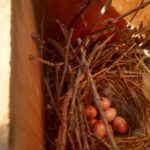
-
Wrens lay several small, reddish eggs.
-
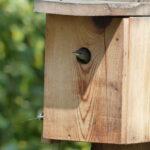
-
Wrens peek out of the box.
-
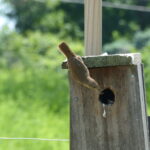
-
Wren adults are busy feeding the young.
On a miraculous day, those eggs become hungry but helpless babies. Mom and dad worked endlessly catching and delivering juicy caterpillars and adult insects to feed the youngsters a high-protein diet. They grow quickly, and a couple of weeks after hatching we see beaks poking out the birdhouse entrance.
It must be scary venturing forth, but mom and dad encourage them to fledge. Out they go. But life is not easy. They need to learn how to fly, where to find food, and how to be safe. Parents help for a while but soon they are on their own while mom and dad make a new nest and raise a second brood.
Launching…. fledging……is a tough transition time for people, bunnies, birds, and just about any other young animal.
by Winding Pathways | Jul 7, 2022 | (Sub)Urban Homesteading, Chickens, Garden/Yard, Nature, Weeds
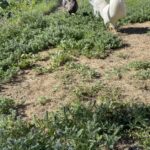
Chickens in run
A chicken run is one tough place for plants to live, and our run at Winding Pathways is even tougher than most.
Every day we let our chickens roam around the run. A bright baking sun broils the sandy soil all day long, so it’s hard to imagine that any plant can thrive there. And, chicken run plants face another challenge. The birds love greenery and usually devour every plant they find. As a result, most chicken runs are just bare dirt that’s either dusty or muddy.
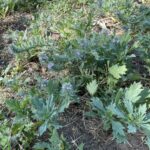
Flower and leaf
Big Bracht Verbena (Verbena bracteata), sometimes called Prostrate Vervain, is up to the challenge. It carpets our chicken run. We didn’t plant it. Verbena moved in on its own. Hopefully, our chickens enjoy viewing the plants’ tiny soft blue flowers.
Big Bracht Verbena is common across much of North America, but it’s easy to overlook. Rarely causing problems, it lives in the most difficult environments. The plant thrives in hot dry gravel soil along roads, in vacant lots, and in sidewalk cracks.
We like having this humble plant in our chicken run. It covers the soil, eliminating mud that follows rain. Chickens absolutely won’t eat it, but they love snatching the insects lured to the plant. It needs no human care, but we sometimes mow it if it gets a big shaggy by late summer.
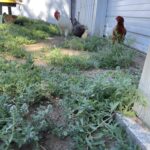
Foraging among verbena
One of nature’s mysteries is how plants have adapted to thrive in all sorts of environments, even harsh ones. Hats off to Big Bracht Verbena.
by Winding Pathways | Jun 16, 2022 | (Sub)Urban Homesteading, Birds, Nature
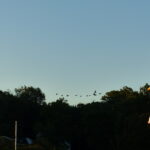
We enjoy the haunting call of geese on the wing.
One of nature’s most alluring sounds is the song of flying Canada geese. Years ago, one had to travel to remote marshes to enjoy it. Not anymore, and a mother goose in Cedar Rapids shows she enjoys urban life.
Giant Canada geese were once nearly exterminated, but a small flock was discovered. Volunteer groups and biologists carefully transplanted geese to new locations, often to urban ponds. Boy, did the huge birds ever love them!
Favorite Foraging
Canada geese love dining on short mowed grass. Lawns surrounding ponds in golf courses and condominiums are perfect habitat. The big birds don’t mind human activity or noise and have expanded so much that many people consider them pests.
Nesting Preferences
Usually, a goose pair chooses a hidden nest site. It may be near an urban area but often is in tall grass or bushes and is hard to spot. Not so one Cedar Rapids goose. She made her nest in a small island of woodchips and dandelions between a parking lot and road. Within sight is a movie theater, tattoo parlor, and medical building!
We are curious about how mom and dad plan to get the goslings to the nearest pond which is a distance away and through traffic.
-
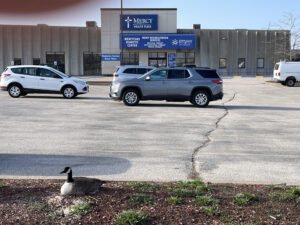
-
The staff have been watching the mother for several weeks.
-
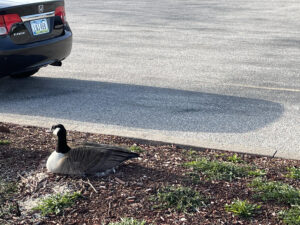
-
Geese are little bothered by traffic or noise.
Sitting, Hatching, and Raising
Goose eggs take about 35 days to hatch. Mom does the incubation but dad is normally close by and is a good protector. They mate for life and can live for decades. When the goslings hatch mom and dad lead them to a pond or river and teach them how to find food.
Our urban goose may be wise. The major nest threat is predation by dogs, raccoons, opossums, and skunks. They all avoid busy parking lots. So the goose couple may have chosen a safe nesting location…..or perhaps they just want to take in a movie, get a tattoo, or visit a doctor!
by Winding Pathways | Jun 9, 2022 | Nature, Trees
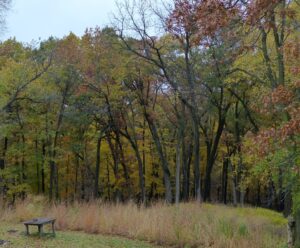
Harvesting Iowa Wood is sustainable.
When we tell people that Iowa is a major producer of some of the world’s most beautiful hardwood, they think we’re nuts. After all, we live in the corn state, where it’s possible to drive a hundred miles viewing only crops.
“Iowa is the sweet spot for the highest quality walnut lumber. Further north it’s too cold for the trees to get big enough and down south they grow so fast the logs contain much white sapwood and wide growth rings. Local walnut is of the highest quality, and it’s beautiful and abundant,” said Thomas Hunt as he led us through the Kendrick Forest Products Mill in Edgewood, Iowa.
Black walnut has been a favored hardwood for paneling, cabinetry, furniture, and gunstocks for hundreds of years. Its dark heartwood has a complex grain pattern that glistens with beauty. It is easy to work with, holds finish well, and is used to create furniture prized for generations.
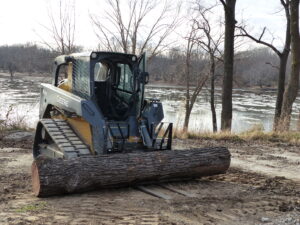
Log ready to be loaded.
Walnut trees are abundant in Iowa, especially in the tightly wooded valleys of the Driftless Area. Trees grow relatively quickly and produce annual nut crops that squirrels bury by the thousands each fall. They only find some for winter snacks. The rest sprout into new trees. When carefully logged walnuts, along with oaks, hickories, ashes, and basswoods produce crops at long intervals and just as sustainably as well-managed farm crops.
Logs are shipped to Kendrick’s mill and sorted by species. During our visit, workers were transforming sugar maple logs into boards. No doubt some will end up flooring beautiful and resilient basketball courts.
Logs enter a huge machine that removes the bark and any dirt clinging to it. They then enter a powerful bandsaw. We watched Zippy operate hand and foot controls that fed each log into the blade that squared off a side. He then flipped it over and cut three more times to create a massive squared-off hunk of maple that next moved to another saw. It cuts the log into one of many things. Sometimes they make railroad ties. We watched the saw create inch-thick lumber.
Boards then go to the “green chain”, a room where workers sort them by grade and stack them up. From there they are cured in the open air and eventually in a kiln that removes moisture.
Finished products are shipped to customers far and wide. Walnut is especially valued overseas. Anyone who loves finely-crafted cabinetry, paneling, or flooring may have Iowa-grown wood processed at Kendrick Forest Products. Iowa’s more than a corn state!
Want to see the mill in action? Kendrick’s offers tours. Information is on their website at kfpiowa.com/take-a-tour/. Can’t get to Eldridge? Enjoy a video tour on their website. And, learn about Monday Mulch!
by Marion Patterson | May 12, 2022 | Birds, Garden/Yard, Nature, Trees
 The distant view and the feel are “Hot August Days.” The near view and sounds are mid-May. With this hot weather, the trees have popped, the fruit trees are in full bloom, and the early garden plants emerging after the cooler and damp weather. We may break a century-old heat record today.
The distant view and the feel are “Hot August Days.” The near view and sounds are mid-May. With this hot weather, the trees have popped, the fruit trees are in full bloom, and the early garden plants emerging after the cooler and damp weather. We may break a century-old heat record today.
Two days ago we had the woodstove running. Now the air conditioner!
Notice the haze in the distance and the sun rising in the east – still six weeks from the Summer Solstice. Humidity levels are high. Winds are calmer after the front blew in.
The trees show emerging leaves and catkins. Insects work the fruit trees and low-growing spring flowers.
Birds are everywhere singing, courting, mating, and building nests. Amazing transformation in two days.
-

-
Deeply cut leaves of the false rue anemone.
-
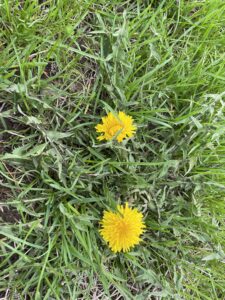
-
going at $8.00 per gallon at wineries, picking blooms from safe places is good income.
-
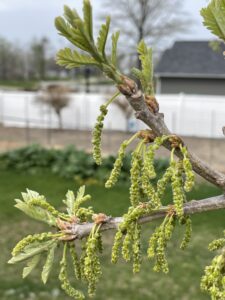
-
the oak popped out in one day with the heat.
-
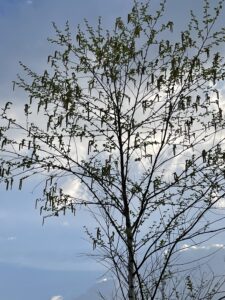
-
birds forage in emerging buds.

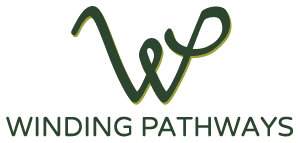














 The distant view and the feel are “Hot August Days.” The near view and sounds are mid-May. With this hot weather, the trees have popped, the fruit trees are in full bloom, and the early garden plants emerging after the cooler and damp weather. We may break a century-old heat record today.
The distant view and the feel are “Hot August Days.” The near view and sounds are mid-May. With this hot weather, the trees have popped, the fruit trees are in full bloom, and the early garden plants emerging after the cooler and damp weather. We may break a century-old heat record today.


